Genre: Puzzle Developer: Atari Games Publisher: Tengen Players: 1-2 Released: 1990
Klax is a 1989 Atari arcade game that has shown up on a number of platforms. It’s a fun “falling blocks” puzzle game that establishes its own brand of gameplay bearing little relation to the common mold of games such as Tetris and Columns.
In Klax, tiles of different colors roll end-over-end down a long ramp toward the bottom of the screen. The player must catch them with a tile catcher that can hold up to 5 tiles at a time, and drop them into the bin below. To score, three or more tiles of the same color must be placed in a row vertically, horizontally, or diagonally – this is a “klax.” Each level or “wave”, of which there are a hundred in the game, has a different objective: either the player must get a certain number of klaxes, a number of a certain kind of klax, score a certain amount of points, or catch a certain amount of tiles without losing. Each objective requires a different kind of strategy.
The gameplay is intuitive, but gets difficult quickly, especially if you’re going for points. I recommend turning difficulty ramping off in the options menu for a more fair difficulty progression. It’s quite a challenge to score the most points possible, as the player can construct combos and klaxes in many different formations, including a giant “X” across the entire bin that, on certain levels, will allow the player to skip most of the game.
As you go on, the game gets FAST. One element, the wild tile that can count as any color, really makes the game even more frenzied, as it’s difficult to keep track of what reactions you may or may not set off with them in place. Unlike most puzzle games, Klax does have an end, and beating the game without running out of continues is an achievement that will require plenty of practice.
The game’s presentation is simple but appealing. It opens with a really amusing slogan, “It is the nineties, and there is time for Klax!” and has a look that’s somewhat dated, but in a charming way. There are a few different in-game backgrounds that, while graphically unimpressive, are colorful and provide a nice backdrop. The game sort of looks like it could actually be physically constructed, like a pinball machine, which is an interesting effect.
The sounds will either charm you or annoy you. There’s a vip-vip-vip as the tiles come down, a sproing when you throw them back up, and other noises you would expect, but there are also audience noises – applause when you finish a level, a woman’s voice saying “Yeah!” and “Oooh!” when you score impressive klaxes, a scream when tiles are lost as if they’re falling to their death, and a pathetic “awwwwww” when you lose the game. Personally, I enjoy the sounds, but I could see them getting on the nerves of some. Turn them on or off as suits you. The music, however, is undeniably repetitive, cacophonous, and awful. It is off by default, and I suggest you leave it that way.
Two players can play simultaneously in Klax, with the screen split down the middle. There’s no interaction between the players, but the ability to play with a friend is nice. If you’re fairly even in skill, one could compete with a friend for score. That’s probably where my one disappointment lies: the high score list, which is not saved when you turn off the game, rendering it pointless. The inability to save scores makes it harder and not as fun to compete with friends and family for the highest score.
Klax is a very replayable puzzle game that is simple, fast, challenging, and fun to play alone or with a friend. It has its own distinct style, in both gameplay and presentation, that makes it stand out from the pack. I highly recommend it to puzzle fans.
SCORE: 9 out of 10


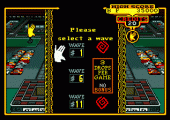
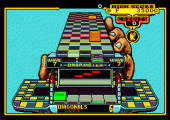
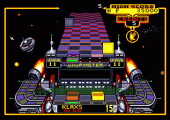
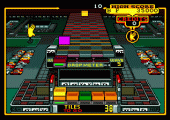
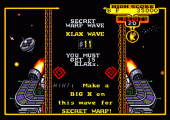
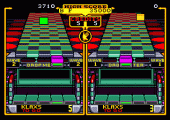
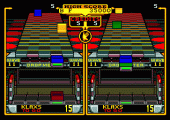
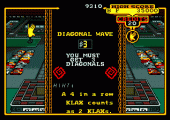
Recent Comments